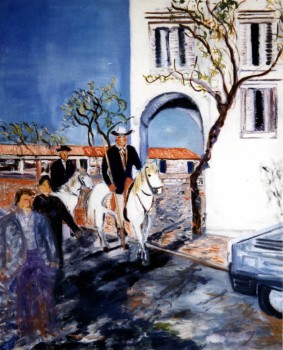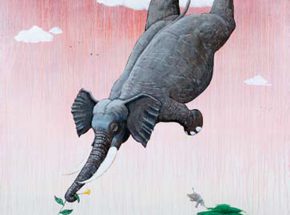

David Black is a New Yorker. In 1983 abstract painter John Hoyland, a teacher at London’s Royal Academy of Art, described Black’s drawings as “quirky and arresting,” with a “twitchy edginess” and “economical and incisive use of line.” Black’s work had “a life of its own” regardless of the subject, and Hoyland told Black “that is what real drawing is all about.” After attending the Printmaking Workshop in New York and several exhibitions of his etchings Black began painting.
In his introduction to a 1988 solo exhibition of Black’s work in London, Frederick Gore, Head of the Exhibition Committee for The Royal Academy wrote, “David Black is a serious painter and his paintings are fun. He paints what he likes, he paints what he has seen and he paints it with a sure sense of comedy, really wild comedy, but just too perceptive and observant to be called satire.” Gore called Black “an extraordinary natural talent and a voracious observer of humanity.” For over ten years Gore and Black painted together in the vineyards, sunflower fields, and orchards of Van Gogh and Cézanne’s Provence. Black describes an incident which
illustrates their relationship: “We were painting in an olive orchard. Freddie was creating a masterful work with color, depth, and perspective in keeping with his position of Head of Painting at St. Martin’s School of Art. I, on the other hand,
was concentrating on the color of the earth and the distant mountains, leaving the olive trees understated. Freddie scolded me and pointed out that the trunks of the trees look like ‘crow’s-feet.’ I immediately started to thicken the trunks. ‘What are you doing?’ asked Freddie. ‘I’m doing what you suggested.’ ‘ Leave it exactly as it is,’ said Freddie. ‘Some people might like it.’”
In 1992 The National Arts Club in New York exhibited Black’s work and published a corresponding book of his line drawings, which belongs to the Guggenheim’s permanent collection. In 1993 Black had a solo exhibition at the DFN Gallery in Soho. John Hoyland wrote the introduction to the catalogue and remarked: “David Black is a wonderful watcher. His painting of Pool is the best I’ve seen since Vincent Van Gogh…His compositions are wonderfully inventive and brave: full of visual surprises, such as the proportions of the clown in The Costume Party… When he paints his New York background, he is at the heart of his culture. One feels the pain, understanding and sympathy that he feels, as one does with everything he paints.”
After the The New Yorker published Black’s Self Portrait At The Night Café Black had exhibitions in Ohio, Texas, New York, New Jersey, Connecticut, and Rhode Island. Critic Anthony Haden-Guest wrote in the introduction to the catalogue
for Black’s second exhibition at DFN Gallery: “David Black’s paintings are playful but in no way slight. The canvases are full of ‘story,’ but long before they take on an illustrational overload, they become painterly. Then you try looking at them as ornament, and their content asserts itself. This must be such an excruciatingly difficult trick to pull off that one assumes Black does it by learned instinct, like swimming.”
Website
http://www.davidblacknyc.com


